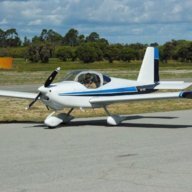-
Posts
2,247 -
Joined
-
Last visited
-
Days Won
19
Information
-
Aircraft
Vans RV-12
-
Location
Perth
-
Country
Australia
Recent Profile Visitors
The recent visitors block is disabled and is not being shown to other users.
rgmwa's Achievements

Well-known member (3/3)
-
rgmwa started following Fiat CR.42 Falco
-
I scratch built one of these as a scale control line model with a third line throttle control many years ago. Sadly, it never flew but I still have the now very much worse for wear relic that I can't bring myself to part with. All the numbers and decals were hand painted. It's hardly a competition winner but not bad for a 16 year old. Never thought that one day I'd have a pilot's licence and build a real aircraft.
-
rgmwa started following Dambusters Footage , Control stick grips. , F4 Phantom and 6 others
-
Ray Allen make a good but expensive range of stick grips. I just have the basic PTT foam grip but you can get much more fancy ones. Available from Skyshop or Aircraft Spruce and probably other places. I ordered mine direct from Ray Allen in the US.
-
Maybe they haven’t discovered floats.
-
Let’s see him do it at half the speed.
-
No. Includes both. The 912ULS engine kit is about $42k. Mine was US$28k.
-
I don't count assembling it as a cost as it was very interesting and good fun. My edited post also included a reasonable paint cost estimate, but I don't think I could justify the cost today. Even at the time it was a lot of money although really no more than a top of the range 4WD or luxury car. Still it was a big commitment and if my wife hadn't been OK with it I wouldn't have done it. It worried me more that it did her.
-
My RV 12 cost AUD $96k at its first flight in 2015. A similarly equipped RV12 kit with a fuel injected Rotax 912iS from Vans today is US $128,800. That's before shipping, painting etc. My engine is a 912 ULS so that would reduce the price to about US$124,000. At the current exchange rate you would be looking at AUD $210 - $230k to build one today including a basic paint scheme.
-

High-wing RV-15: progress report from Van's
rgmwa replied to Garfly's topic in AUS/NZ General Discussion
Good to see this project still progressing well after all the problems they've had, and that they're taking the time to do a thorough job on design and testing. Should be a very capable aircraft, but it won't be cheap. -

Giant 25 KG RC Czech Air Force Mil Mi-24V 'Hind' Attack Helicopter
rgmwa replied to dominicm's topic in Remote Control
That's a lot of money to spend on a model. -
What would be the point of flying a jetski or quad bike to open water at great expense when they typically launch off the beach or a boat ramp for nothing? As Onetrack said, it's very hard to see any commercial justification for a new amphibian, at least in Australia. As a tourist transport in the Caribbean or the Great Barrier Reef it might have more value, but there are floatplanes that already service that market, so it would face stiff competition.
-
I wouldn't put carpet anywhere near the prop but definitely sweep away all the gravel from the area and anything else that's loose.
-
Interesting colourised footage of this well known story. A lot of it looks like real footage but some looks like AI to me.
-
Beach umbrella would look good on the grader (a couple of pages back).











